Last Updated on 5 months by admin
Determining the ideal number of goldfish to keep in a 10-gallon tank can be a bit challenging. While there is no set rule, several factors need to be considered. The size of the fish, the tank’s capacity, and the accessories in the tank all play a role in determining the optimal goldfish count. It is generally recommended to have 1 to 3 goldfish in a 10-gallon tank, depending on their size. However, it is important to ensure that the fish have enough space to swim and that the tank can handle their waste. The goal is to provide a comfortable and balanced environment for the goldfish to thrive.
Key Takeaways:
- The recommended goldfish count in a 10-gallon tank is 1 to 3, depending on the size of the fish.
- Consider the swimming space and waste management capacity of the tank when determining the goldfish count.
- Creating a comfortable and balanced environment is crucial for the well-being of goldfish.
- Regular monitoring and maintenance are essential to ensure the optimal health of the fish.
- Consulting with experts and researching specific goldfish species can help in making informed decisions.
Factors to Consider When Stocking a Goldfish Tank

When it comes to stocking a goldfish tank, there are several important factors to consider. These factors will help you determine the appropriate number of goldfish to keep in your tank while ensuring their well-being and maintaining a healthy environment.
Size of the Fish
The size of the goldfish plays a significant role in determining the number of fish that can be stocked in a tank. Larger goldfish require more space to swim and move around comfortably. It is essential to consider the adult size and growth potential of the goldfish species you plan to keep. Providing sufficient space is crucial for the overall health and happiness of the fish.
Tank Capacity
The capacity of the tank is another essential factor to consider when stocking goldfish. A tank should be able to handle the waste produced by the fish. Goldfish produce a significant amount of waste, and it is important to ensure that the tank’s filtration system can effectively manage the waste load. Overstocking a tank can lead to poor water quality and negatively impact the health of the goldfish.
Accessories and Plants
It is crucial to consider the accessories and plants in the tank when stocking goldfish. These additions should not overcrowd the tank and limit the swimming space for the fish. Goldfish need ample space to swim, explore, and exhibit their natural behaviors. Balancing the number of fish with the appropriate accessories and plants will help create a harmonious and stimulating environment for the goldfish.
General Guidelines and Requirements
Following general guidelines and requirements for goldfish tanks is essential for their well-being. There are recommended stocking limits based on the size and type of goldfish. These guidelines help ensure that the goldfish have enough space, oxygen, and filtration capacity to thrive. Adhering to these guidelines will contribute to a healthy and happy goldfish tank.
To summarize, when stocking a goldfish tank, consider the size of the fish, the tank’s capacity, the accessories and plants, and follow general guidelines and requirements. By carefully considering these factors, you can create an optimal goldfish tank that provides a comfortable and balanced environment for your finned friends.
| Factors to Consider | Importance |
|---|---|
| Size of the Fish | Ensures sufficient swimming space. |
| Tank Capacity | Handles waste produced by goldfish. |
| Accessories and Plants | Prevents overcrowding and provides stimulation. |
| General Guidelines and Requirements | Maintains a healthy environment for goldfish. |
Stocking Goldfish in Different Tank Sizes
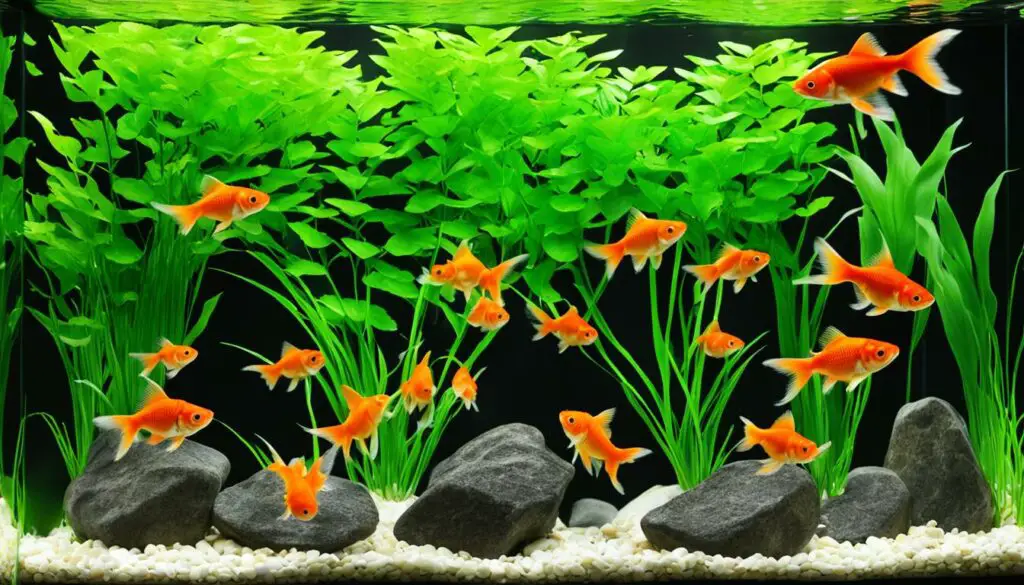
The size of the tank plays a crucial role in determining the number of goldfish that can be safely kept. It is important to provide enough space for the goldfish to swim and thrive, while also ensuring a healthy environment with adequate filtration. Let’s explore the recommended goldfish stocking guidelines based on different tank sizes:
2-Gallon Tank
In a 2-gallon tank, it is best to start with 1 to 3 small-sized goldfish. These tanks are suitable for beginners or those with limited space. By keeping the goldfish count low, you can provide them with enough room to swim and reduce the chances of overcrowding. Remember to monitor the water parameters regularly and perform frequent water changes to maintain optimal conditions.
5-Gallon Tank
Moving up to a 5-gallon tank allows for a slightly larger goldfish count. In this tank size, you can comfortably accommodate 4 to 6 goldfish, depending on their size and growth potential. With the additional space, the goldfish will have more room to explore and exhibit their natural behaviors. It is recommended to include live plants and other accessories to create a stimulating and comfortable environment for the fish.
10-Gallon Tank
A 10-gallon tank is a popular choice for goldfish enthusiasts. It offers more space and allows for a larger goldfish count. In this tank size, it is recommended to keep the goldfish count between 6 to 8, again depending on their size and growth potential. It is crucial to strike a balance between providing enough space for the goldfish to swim and ensuring proper filtration to maintain water quality. Adding live plants can enhance the tank’s aesthetics and provide additional benefits to the goldfish.
Remember, these stocking recommendations are general guidelines. It is important to consider the specific needs of your goldfish species and monitor their behavior and water conditions regularly. By providing an optimal tank size and maintaining a healthy environment, you can ensure the well-being and happiness of your goldfish.
Importance of Tank Shape and Size
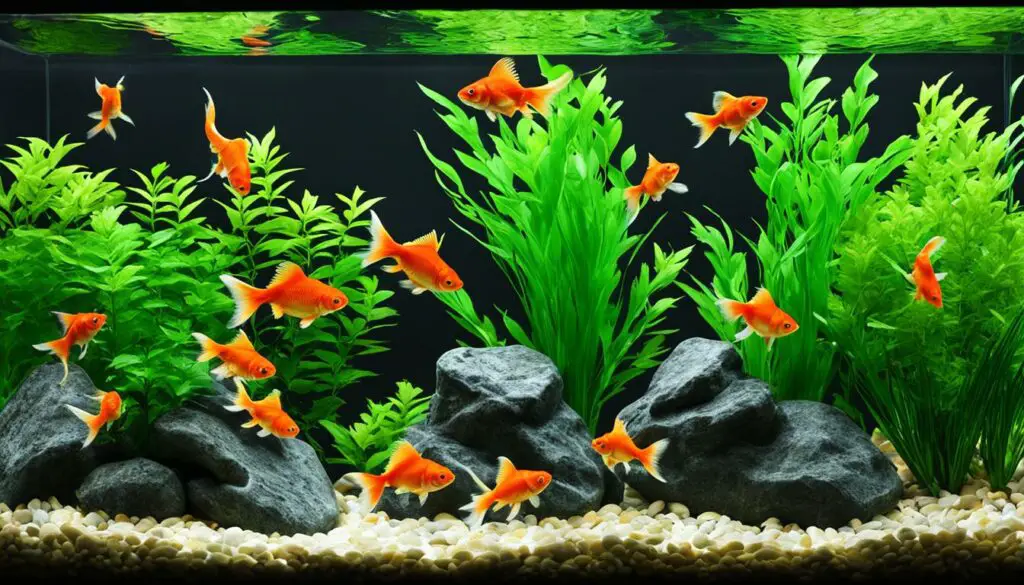
When it comes to creating the perfect goldfish tank, the shape and size are vital considerations. Goldfish are known for their need for ample oxygen and their tendency to produce a significant amount of waste. Therefore, it is crucial to choose a tank that can accommodate their specific requirements.
An elongated tank shape is highly recommended for goldfish, as it provides them with more swimming space compared to a tall tank. This allows the goldfish to move freely and exhibit their natural behavior, promoting their overall well-being.
The tank size is a key factor in determining the optimal goldfish count. It is generally recommended to go for a 20 to 30-gallon tank for goldfish. This ensures that the goldfish have enough space to swim and that the tank can handle their waste effectively. As a general rule of thumb, increasing the tank size by 10 gallons for each additional goldfish is advised to provide adequate space and minimize waste build-up.
To further illustrate the importance of tank shape and size, consider the example below showcasing the ideal tank shape and size for different goldfish counts:
| Goldfish Count | Tank Size |
|---|---|
| 1-3 | 20-30 gallons |
| 4-6 | 30-40 gallons |
| 7-9 | 40-50 gallons |
As shown in the table above, the tank size should be adjusted according to the number of goldfish being kept. Providing adequate space not only allows the goldfish to thrive but also helps maintain water quality by minimizing waste accumulation.
By carefully considering the shape and size of the goldfish tank, aquarists can create an environment that promotes the well-being of their fish. Remember, a spacious and appropriately sized tank is essential for the comfort and health of goldfish.
Managing Waste Load in a Goldfish Tank
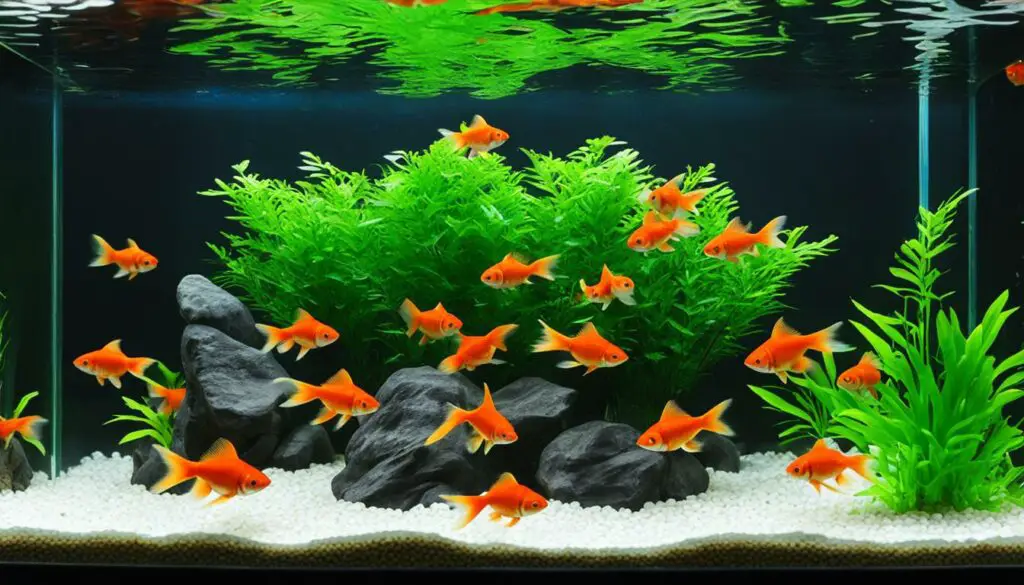
Proper waste management is essential for maintaining water quality and the overall health of goldfish in a tank. By effectively managing the waste load, aquarists can create a healthy and thriving environment for their fish. This section will discuss the importance of filtration, the role of live plants, regular tank maintenance, and the significance of providing high-quality fish food.
The Role of Filtration
Filtration is a critical component in maintaining water quality in a goldfish tank. It helps remove toxic waste compounds like ammonia and nitrates, promoting a healthy environment for the fish. When selecting a filtration system, consider both the tank size and the number of goldfish being kept. A properly sized filter ensures efficient waste removal and supports optimal water conditions for goldfish. Here is a detailed table highlighting different filtration options based on tank size and goldfish count:
| Tank Size | Goldfish Count | Filtration System |
|---|---|---|
| 10 gallons | 1-3 | Hanging Filter |
| 20 gallons | 4-6 | Canister Filter |
| 30 gallons | 7-10 | External Sump Filter |
The Role of Live Plants
Live aquarium plants can also contribute to waste management in a goldfish tank. They absorb nitrogen waste, including nitrates, through a process called assimilation. This helps reduce the overall waste load in the tank and promotes better water quality. Additionally, live plants provide oxygenation and create a more natural and aesthetically pleasing environment for the goldfish. Here is a list of suitable live plants for a goldfish tank:
- Anubias
- Java Fern
- Hornwort
- Amazon Sword
Regular Tank Maintenance
Maintaining a regular tank maintenance routine is crucial for waste load management. Test the water parameters regularly, including ammonia, nitrite, nitrate, pH levels, and temperature. This helps monitor the waste levels and ensure they remain within appropriate ranges. Regular water changes should be performed to remove accumulated waste and keep the water clean and healthy for the goldfish. Aim for a 20% water change every one to two weeks for optimal results.
High-Quality Fish Food
Providing high-quality fish food to your goldfish can also contribute to waste load management. Choosing a balanced diet that is easily digestible reduces the amount of waste produced by the fish. Look for fish food specifically formulated for goldfish, which contains essential nutrients and minimizes the risk of overfeeding. Proper portion control ensures the goldfish consume only what they need, reducing the amount of uneaten food that can contribute to waste buildup in the tank.
By implementing these waste management strategies, aquarists can ensure a clean and healthy environment for their goldfish. Effective filtration, the inclusion of live plants, regular tank maintenance, and providing high-quality fish food all play crucial roles in maintaining water quality and promoting the overall well-being of the goldfish.
Providing Adequate Swimming Space for Goldfish
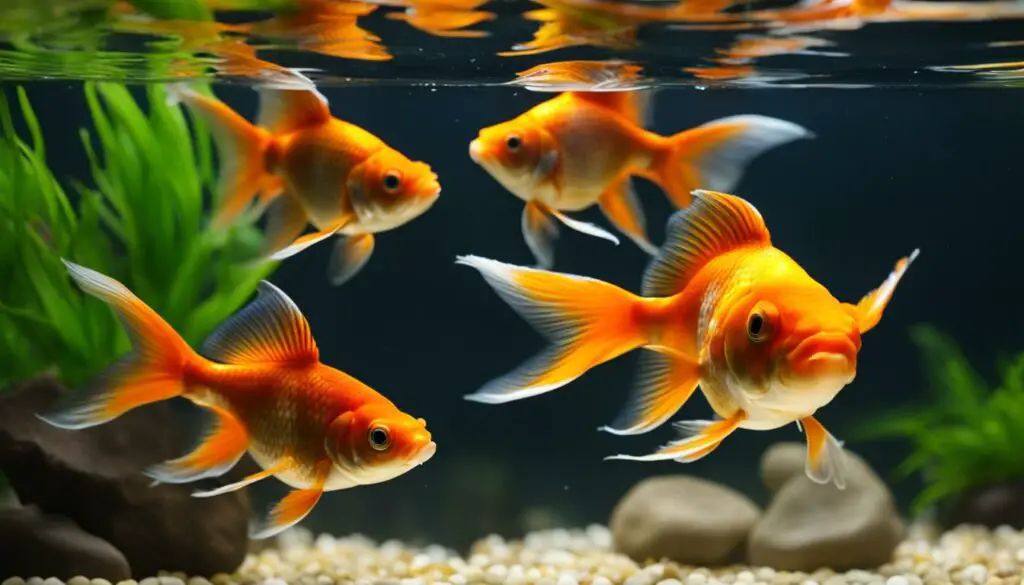
Goldfish require ample swimming space to thrive and stay healthy. The commonly recommended rule of thumb is to provide 1 inch of fish body length per gallon of water. However, this rule may vary based on the specific needs and growth potential of the goldfish species being kept. It is important to consider the maximum adult size of the fish and choose an appropriately sized tank.
Providing enough swimming space allows the goldfish to move freely and exhibit their natural behavior. Tank dimensions should be taken into consideration to ensure the goldfish have room to swim, turn around comfortably, and maintain good overall health.
To illustrate the relationship between goldfish size and tank size, here is a general guide:
| Goldfish Size | Recommended Tank Size |
|---|---|
| Small (2-4 inches) | 20-30 gallons |
| Medium (4-6 inches) | 30-40 gallons |
| Large (6-8 inches) | 40-50 gallons |
The table above provides a general guideline on the recommended tank size based on the goldfish’s size, allowing them enough space to swim freely and comfortably. Remember, these are just estimates, and it ultimately depends on the specific needs of your goldfish.
Considerations for Goldfish Aggression Levels
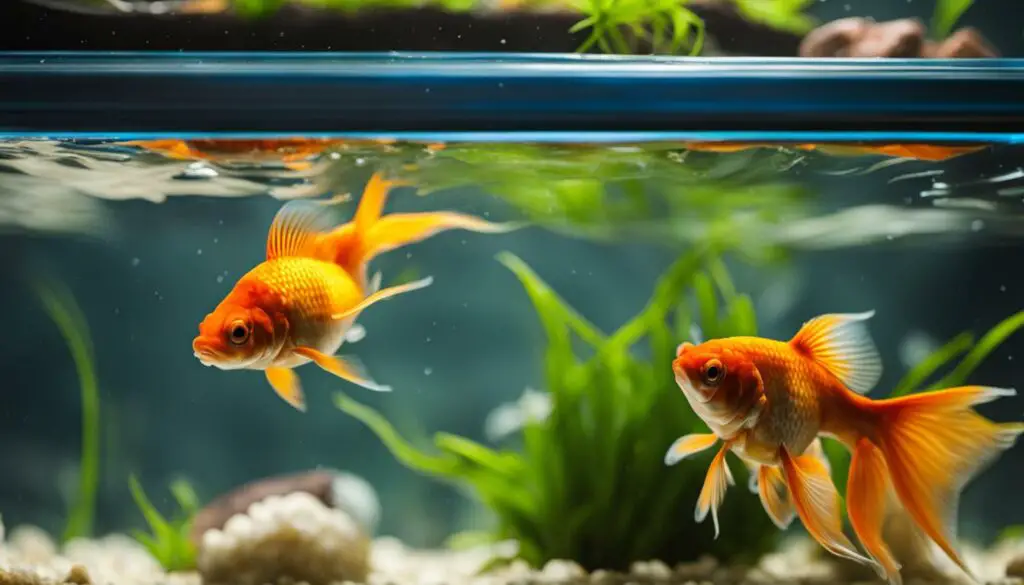
Goldfish aggression levels can vary depending on the species and individual temperament. When keeping multiple goldfish in a tank, it is essential to consider the compatibility of the species to prevent conflicts and potential harm to the fish.
Mixing aggressive and peaceful goldfish can lead to territorial disputes and aggressive behaviors, causing stress and injury. To create a harmonious tank community, it is important to provide enough hiding spots, decorations, and plants to create separate territories within the tank.
By including these features, goldfish can establish their own areas, reducing the risk of aggression and promoting a more peaceful environment. Careful selection of tank mates based on their temperament and swimming behaviors is crucial to minimize conflict.
To ensure a stress-free tank environment, it is recommended to research and understand the behavior of each goldfish species. Some species are naturally more aggressive, while others are more peaceful. By choosing compatible tank mates, you can foster a harmonious goldfish tank community and promote the well-being of all the fish.
Remember, a peaceful and stress-free tank environment is crucial for the health and happiness of your goldfish!
Determining Stocking Levels Using Nitrate Levels
Nitrate levels can play a crucial role in determining the stocking levels in a goldfish tank and maintaining the overall water quality. By measuring and managing nitrate levels, aquarists can create a healthy and balanced environment for their goldfish. Nitrate levels below 40 ppm are generally considered safe for goldfish. Keeping nitrate levels within this range helps ensure optimal water conditions and the well-being of the fish.
When stocking a goldfish tank, it is recommended to start with a few goldfish and monitor the nitrate levels over a span of several weeks. This allows for careful observation of the impact on water quality. If the nitrate levels remain within the desired range and the water quality remains stable, additional goldfish can be gradually added to the tank.
To prevent overcrowding and maintain optimal water conditions, it is important to monitor the population density closely. Overstocking the tank can lead to increased nitrate levels and negatively impact water quality, which can be harmful to the goldfish’s health.
Tips for measuring and managing nitrate levels:
- Regularly test the water using a reliable nitrate test kit
- Perform water changes to reduce nitrate levels if they exceed the recommended range
- Avoid overfeeding the goldfish as excess food can contribute to increased nitrate levels
- Maintain a proper filtration system that effectively removes waste and helps control nitrate levels
By monitoring and managing nitrate levels, aquarists can ensure a healthy and thriving goldfish tank. It is important to maintain optimal water conditions to provide a safe and suitable environment for the goldfish to grow and thrive.
Maintaining a Balanced Ecosystem in a Goldfish Tank
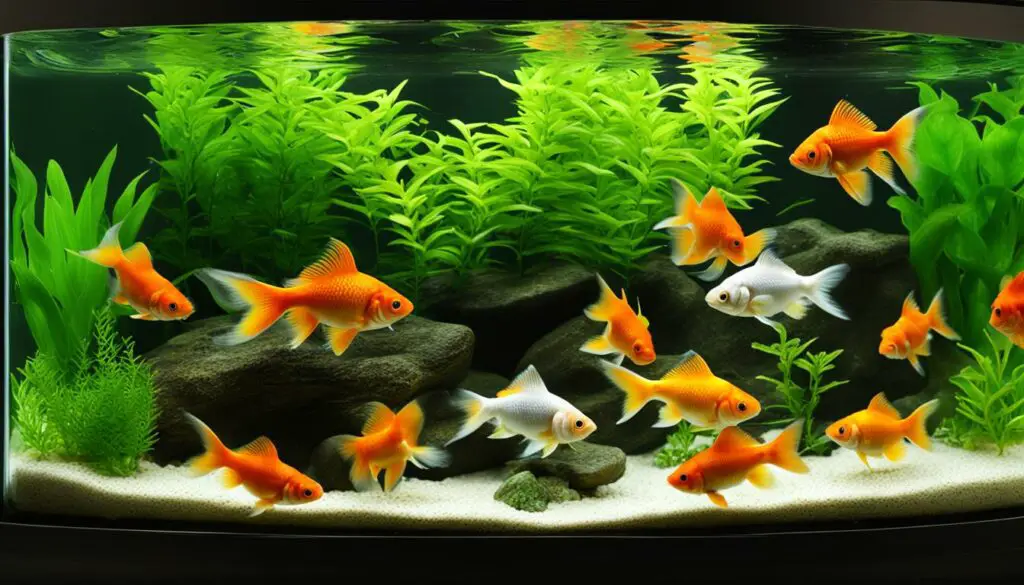
A balanced ecosystem is crucial for ensuring the well-being and health of goldfish in a tank. By creating a harmonious environment, goldfish can thrive and exhibit their natural behaviors. One of the key elements in achieving a balanced ecosystem is incorporating live aquarium plants into the goldfish tank.
Aquarium plants play a vital role by absorbing waste products generated by the goldfish and providing oxygen through photosynthesis. They also provide shelter and hiding spots, reducing stress levels in the fish. When selecting plants for a goldfish tank, it is important to choose those that are compatible with goldfish and can withstand their nibbling tendencies.
Regular water changes are another critical aspect of maintaining a balanced ecosystem in a goldfish tank. Water changes help remove excess waste, dilute toxins, and maintain optimal water quality. It is recommended to follow a consistent maintenance schedule for water changes to ensure a healthy and stable environment for the goldfish.
Monitoring chemical levels in the tank is essential for maintaining a balanced ecosystem. Factors such as ammonia, nitrite, nitrate, pH levels, and water hardness should be regularly tested and adjusted as necessary to provide the best possible conditions for the goldfish. Maintaining suitable chemical parameters ensures the goldfish thrive and reduces the risk of health issues caused by poor water quality.
Benefits of Maintaining a Balanced Ecosystem in a Goldfish Tank:
- Promotes natural behaviors and reduces stress in goldfish
- Improves overall health and well-being of goldfish
- Enhances water quality and reduces the risk of disease
- Creates a more visually appealing and natural habitat
“A balanced ecosystem in a goldfish tank is vital for providing the best possible environment for the fish to thrive and exhibit their natural behaviors.” – [Your Name, Goldfish Enthusiast]
| Key Elements | Actions |
|---|---|
| Live Aquarium Plants | Choose goldfish-friendly plants that absorb waste and provide oxygen |
| Regular Water Changes | Perform water changes according to a maintenance schedule to remove excess waste and maintain optimal water quality |
| Chemical Level Monitoring | Regularly test and adjust ammonia, nitrite, nitrate, pH levels, and water hardness to ensure suitable conditions |
The Role of Filtration and Tank Maintenance
Proper filtration and tank maintenance are crucial for ensuring the overall health and well-being of your goldfish. These essential tasks help maintain optimal water quality in the tank, providing a clean and healthy environment for your finned friends to thrive.
Choosing the right filtration system is paramount in maintaining a goldfish tank. The size of the tank and the waste load generated by your goldfish will determine the type and capacity of the filtration system needed. A reliable filtration system effectively removes harmful toxins and waste, promoting a balanced ecosystem.
Regular tank maintenance is equally important. Water testing should be conducted regularly to check crucial parameters such as ammonia, nitrite, nitrate, and pH levels. Performing routine water changes helps remove accumulated toxins and keeps the water quality at optimal levels.
It is crucial to clean the tank and the filter periodically to prevent the buildup of debris and waste. This ensures that the filtration system functions effectively in removing impurities from the water. Regular filter maintenance will help prolong its lifespan and efficiency.
By providing adequate filtration and diligently maintaining your goldfish tank, you create a clean and healthy environment for your goldfish to thrive in. This not only enhances their overall health and longevity but also reduces the risk of diseases and other health issues.
Benefits of Proper Filtration and Tank Maintenance:
- Removes harmful toxins and waste from the water
- Promotes a balanced and healthy ecosystem
- Reduces the risk of diseases and health issues
- Enhances the overall health and longevity of your goldfish
“Proper filtration and regular tank maintenance are essential for optimizing water quality and ensuring the well-being of your goldfish.”
Keeping a close eye on the filtration system and performing routine maintenance tasks will help create a thriving and pristine environment for your goldfish. With clean and well-maintained water, your goldfish will flourish, showcasing their vibrant colors and playful behavior.
Conclusion
After considering various factors such as fish size, tank capacity, waste load management, swimming space, and aggression levels, it is clear that creating a balanced and healthy environment is crucial for the goldfish to live and thrive in a 10-gallon tank. To achieve this, aquarists should provide an appropriate tank size that suits the goldfish count and allows for comfortable swimming space.
In addition, choosing the right filtration system to effectively manage waste is essential for maintaining water quality. Regular tank maintenance, including water testing and water changes, helps to keep the waste levels in check and ensure a clean and healthy environment for the goldfish.
By following guidelines and understanding the specific needs of the goldfish species being kept, aquarists can create an optimal goldfish tank that promotes the well-being and happiness of the fish. With careful consideration of fish size, tank capacity, waste load management, swimming space, and aggression levels, aquarists can provide a comfortable and balanced environment for their goldfish to thrive in a 10-gallon tank.
FAQ
How many goldfish can I keep in a 10-gallon tank?
It is generally recommended to have 1 to 3 goldfish in a 10-gallon tank, depending on their size.
What factors should I consider when stocking a goldfish tank?
Factors to consider include the size of the fish, the tank’s capacity, and the accessories in the tank.
What is the optimal goldfish count for different tank sizes?
In a 2-gallon tank, it is best to start with 1 to 3 small-sized goldfish. In a 5-gallon tank, 4 to 6 goldfish can be accommodated. In a 10-gallon tank, a recommended count is between 6 to 8 goldfish.
How important is the shape and size of the goldfish tank?
The shape and size of the tank are crucial factors in providing enough swimming space and accommodating the waste load. An elongated tank shape is preferred over a tall tank.
How can I manage waste load in a goldfish tank?
Proper filtration, regular tank maintenance, and the inclusion of live plants are essential for managing waste load and maintaining water quality.
How much swimming space do goldfish need?
Goldfish require ample swimming space. The commonly recommended rule is to provide 1 inch of fish body length per gallon of water.
How should I consider the aggression levels of goldfish when stocking a tank?
It is important to consider the compatibility of goldfish species and provide hiding spots to minimize conflicts.
How can I determine stocking levels in a goldfish tank using nitrate levels?
Nitrate levels below 40 ppm indicate suitable stocking levels. Gradually adding goldfish while monitoring nitrate levels is advisable.
How can I maintain a balanced ecosystem in a goldfish tank?
Including live aquarium plants, regular water changes, and monitoring chemical levels help maintain a balanced ecosystem.
What is the role of filtration and tank maintenance?
Proper filtration and regular maintenance tasks such as water testing and changes are essential for maintaining optimal water quality and the overall health of goldfish.
Source Links
- https://fishlab.com/how-many-fish-per-gallon/
- http://pearlscale.weebly.com/choosing-the-tank.html
- https://www.aquariumcoop.com/blogs/aquarium/how-many-fish


